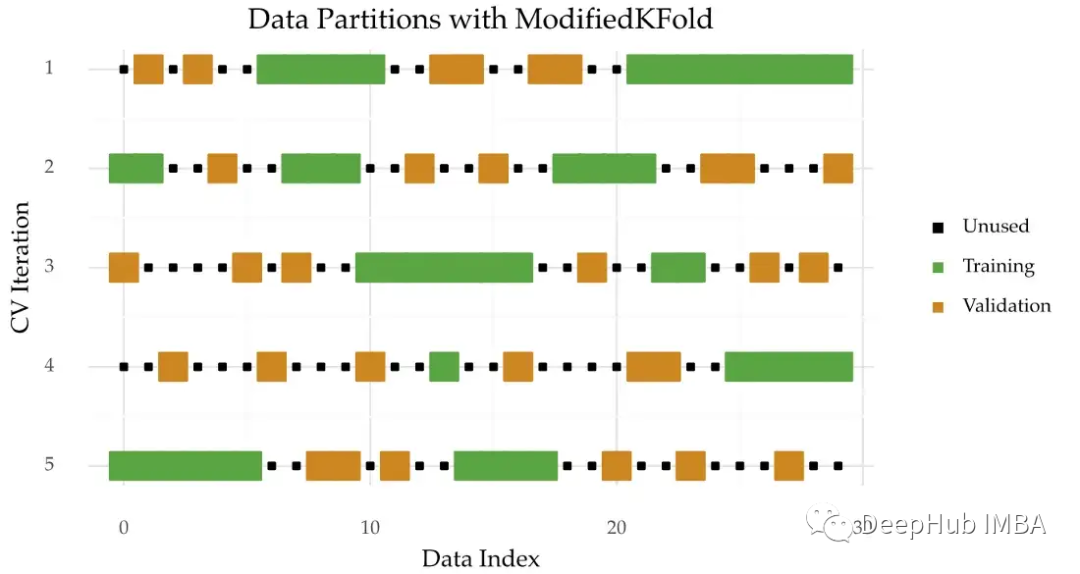机器学习竞赛中的交叉验证策略:赢得数据科学挑战赛的秘诀:竞赛中的交叉验证策略,提升你的竞赛成绩
发布时间: 2024-09-04 05:29:54 阅读量: 113 订阅数: 55 


# 1. 交叉验证策略的基本概念
## 1.1 交叉验证的定义与重要性
交叉验证(Cross-Validation)是一种评估统计分析方法在独立数据集上性能的技术。它通过将数据集分成若干小组,其中一部分做为训练集,另一部分做为验证集,以此循环,最终计算所有分组的平均性能来评估模型。这种策略可以帮助我们了解模型对未见数据的泛化能力,并在一定程度上解决过拟合的问题。
## 1.2 交叉验证的主要类型
最常用的是 K 折交叉验证,它将数据集分成 K 个互不相交的子集,并轮流使用其中 K-1 个子集进行训练,剩下的一个子集用于验证。这种方法适用于数据集大小适中时的评估。除此之外,还有留出法(Holdout Validation)和留一法(Leave-One-Out Cross-Validation),它们是交叉验证的两种特殊情况,分别适用于数据集较大或较小的情景。
## 1.3 实施交叉验证的场景
在实际应用中,交叉验证策略常用于机器学习模型的选择和调参过程中。它不仅能够给出模型性能的估计,还能辅助我们对模型的超参数进行优化。本章节将深入浅出地讲解交叉验证的理论基础和实践操作,帮助读者掌握这一重要技能。
# 2. 理论基础与数学原理
### 2.1 交叉验证的数学基础
交叉验证的数学基础建立在统计学的评估指标和损失函数上。理解这些原理是设计高效验证策略的关键。
#### 2.1.1 预测准确性的评估指标
预测准确性的评估指标是评价模型性能的量化方法,主要分为分类问题和回归问题两大类。
分类问题中常用的评估指标包括准确率(Accuracy)、精确率(Precision)、召回率(Recall)、F1分数(F1-Score)等。准确率是模型正确预测的样本数占总样本数的比例。精确率是模型预测为正样本且实际也为正样本的比例。召回率是实际为正样本且被模型正确预测的比例。F1分数是精确率和召回率的调和平均数,用于平衡精确率和召回率。
回归问题中常见的指标有均方误差(MSE)、均方根误差(RMSE)、平均绝对误差(MAE)等。均方误差是预测值与真实值差的平方的平均值,均方根误差是均方误差的平方根,平均绝对误差是预测值与真实值差的绝对值的平均值。
```python
from sklearn.metrics import accuracy_score, precision_score, recall_score, f1_score
from sklearn.metrics import mean_squared_error, mean_absolute_error
# 示例代码:计算分类问题的评估指标
y_true = [1, 0, 1, 1, 0]
y_pred = [1, 0, 0, 1, 1]
accuracy = accuracy_score(y_true, y_pred)
precision = precision_score(y_true, y_pred)
recall = recall_score(y_true, y_pred)
f1 = f1_score(y_true, y_pred)
print(f"Accuracy: {accuracy}")
print(f"Precision: {precision}")
print(f"Recall: {recall}")
print(f"F1 Score: {f1}")
```
#### 2.1.2 损失函数与优化目标
损失函数衡量的是模型预测值与真实值之间的差异。它是模型训练过程中的优化目标,通过最小化损失函数来调整模型参数。
对于分类问题,常用的损失函数有交叉熵损失(Cross-Entropy Loss)。对于回归问题,常用的损失函数有均方误差(MSE)损失。
交叉熵损失函数主要用于衡量两个概率分布之间的差异,适用于概率预测模型,如逻辑回归。均方误差损失函数衡量的是预测值和实际值的差值的平方的均值,常用于线性回归模型。
```python
import torch.nn as nn
import torch.optim as optim
# 示例代码:定义损失函数和优化器
model = ... # 定义模型
criterion = nn.CrossEntropyLoss() # 定义交叉熵损失函数
optimizer = optim.SGD(model.parameters(), lr=0.01) # 定义随机梯度下降优化器
```
### 2.2 交叉验证的类型与选择
交叉验证的类型包括留出法、K折交叉验证和留一法。不同类型的交叉验证有其特定的应用场景和优缺点。
#### 2.2.1 留出法、K折交叉验证和留一法
留出法是一种简单直观的方法,它将数据集分为训练集和测试集,通常按照7:3或8:2的比例。这种方法的优点是计算简单,缺点是结果依赖于划分方式。
K折交叉验证是将数据集随机分为K个大小相等的子集,使用其中K-1个子集作为训练集,剩余一个子集作为验证集,重复K次,每次选取不同的验证集。这种方法的优势在于减少了留出法对数据集划分的依赖。
留一法是一种极端的K折交叉验证,K等于样本数。每次验证集只包含一个样本,其余作为训练集。留一法的计算量大,但能得到最无偏的估计。
#### 2.2.2 选择交叉验证策略的依据
选择交叉验证策略主要依据数据量大小、模型复杂度和计算资源。当数据量很大时,可以选择K折交叉验证,因为它能有效利用数据;当数据量较小时,留出法或留一法可能更适合。模型越复杂,越需要足够的数据来确保评估的准确性。
#### 2.2.3 特定情况下的交叉验证变种
在特定情况下,标准的交叉验证方法可能需要变种以适应特定问题。例如,在时间序列数据中,可能需要时间顺序交叉验证来确保数据的时间依赖性不被破坏。在处理不平衡数据时,可能会采用分层K折交叉验证来保持类别分布的均衡。
### 2.3 超参数调整与交叉验证
超参数调整是机器学习模型优化的重要环节,交叉验证在这一过程中发挥着关键作用。
#### 2.3.1 超参数对模型性能的影响
超参数是指在模型训练之前设置的参数,它们控制着学习过程和模型结构。例如,在神经网络中,学习率、层数、每层的节点数都是超参数。不同的超参数设置会导致模型性能有显著差异。
#### 2.3.2 超参数优化策略
超参数优化策略包括网格搜索、随机搜索、贝叶斯优化等。网格搜索通过穷举所有可能的超参数组合来寻找最佳配置,虽然全面但效率低下。随机搜索随机选择超参数组合,更加高效。贝叶斯优化则利用前一次的评估结果来指导下一步搜索,能更快收敛到最优解。
```python
from sklearn.model_selection import GridSearchCV
from sklearn.ensemble import RandomForestClassifier
from sklearn.datasets import load_iris
# 示例代码:网格搜索优化超参数
iris = load_iris()
X, y = iris.data, iris.target
rf = RandomForestClassifier()
param_grid = {'n_estimators': [50, 100], 'max_depth': [None, 5, 10]}
grid_search = GridSearchCV(estimator=rf, param_grid=param_grid, cv=5)
grid_search.fit(X, y)
print("Best parameters:", grid_search.best_params_)
```
#### 2.3.3 交叉验证在超参数优化中的作用
在超参数优化过程中,交叉验证用于评估模型在不同超参数设置下的性能。它通过多次划分数据集并训练模型来保证评估结果的稳定性和可靠性。这样,我们可以比较不同超参数配置下的模型性能,并选择最佳配置。
交叉验证为超参数优化提供了更加严谨的评估框架,确保选出的超参数不会因为偶然因素导致模型在未知数据上表现不佳。
# 3. 交叉验证的实践技巧
### 3.1 实现交叉验证的常用工具
#### 3.1.1 Python中的交叉验证工具
在Python中,实现交叉验证的最常使用的库是Scikit-learn,它提供了一系列强大的工具来简化交叉验证的过程。Scikit-learn库中的`model_selection`模块包含了诸如`cross_val_score`、`cross_val_predict`以及`KFold`、`StratifiedKFold`等函数和类,使得交叉验证的执行变得简单。
下面是一个使用`cross_val_score`函数进行K折交叉验证的示例代码:
```python
from sklearn.model_selection import cross_val_score, KFold
from sklearn.datasets import load_iris
from sklearn.linear_model import LogisticRegression
# 加载示例数据集
iris = load_iris()
X, y = iris.data, iris.target
# 创建逻辑回归模型实例
logreg = LogisticRegression(max_iter=10000)
# 创建KFold实例进行10折交叉验证
kf = KFold(n_splits=10, shuffle=True, random_state=1)
# 计算交叉验证的分数
cv_scores = cross_val_score(logreg, X, y, cv=kf)
print("Cross-validation scores:", cv_scores)
print("Average cross-validation score: {:.2f}".format(cv_scores.mean()))
```
在上述代码中,首先导入了必要的模块,并加载了鸢尾花(Iris)数据集。然后创建了一个逻辑回归分类器实例`logreg`。接着,定义了一个10折的`KFold`交叉验证器实例`kf`,其中`shuffle=True`表示在每次交叉验证之前随机打乱数据,`random_state`确保了每次运行代码时的随机结果一致。最后,使用`cross_val_score`函数计算了交叉验证的分数,并输出了各个折的分数以及平均分数。
#### 3.1.2 R语言及其他数据分析工具
除了Python,R语言也是数据分析领域广泛使用的一种语言。在R中,可以使用`caret`或`mlr`包来执行交叉验证。下面以`caret`包为例进行说明。
```R
library(caret)
data(iris)
# 设置交叉验证参数
train_control <- trainControl(method = "cv", number = 10)
# 训练逻辑回归模型并应用交叉验证
model <- train(Species~., data = iris, method = "glm", trControl = train_control)
# 输出模型结果
print(model)
```
在这段R代码中,首先加载了`caret`包以及鸢尾花数据集。然后设置了交叉验证的参数,指定使用10折交叉验证。接着使用`train`函数训练了一个逻辑回归模型,并将之前设置的交叉验证参数传入。最后,输出了训练得到的模型结果,其中包含了交叉验证的详细信息。
### 3.2 实际数据集的交叉验证实例
#### 3.2.1 实战:使用Scikit-learn进行交叉验证
在这一小节中,我们将使用Scikit-learn库对一个实际的数据集应用交叉验证。我们将使用著名的乳腺癌数据集(Breast Cancer Wisconsin dataset),该数据集包含了乳腺癌肿瘤的多个特征,并提供了良性和恶性肿瘤的标签。
```python
from sklearn.datasets import load_breast_cancer
from sklearn.ensemble import RandomForestClassifier
from sklearn.model_selection import cross_val_score
# 加载数据集
cancer = load_breast_cancer()
# 创
```
0
0





